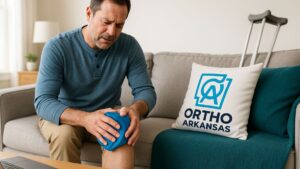
Dealing with joint pain can be difficult, especially when allergies come into play. Seasonal allergies cause a range of symptoms — sneezing, itchy eyes and nasal congestion. However, many people may not realize that their allergies can also be the cause of their joint pain.
During pollen season, when allergens are abundant in the air, our immune system is triggered. This response causes inflammation, which is the body’s way of healing itself, but it can also lead to painful flare-ups.
Causes of Joint Pain During Allergy Season
- Inflammation: Swelling occurs as the body tries to fight off allergies.
- Fatigue: Battling allergies can leave you feeling tired, which can make joint pain worse.
- Muscle Strain: Symptoms like sneezing and coughing can also strain your muscles and joints.
Rheumatoid Conditions and Allergies
Those with rheumatoid conditions, such as arthritis, may especially notice increased symptoms during the high-pollen season. Rheumatoid arthritis is an autoimmune disease that causes swelling in the joints as the body mistakenly attacks its own tissues. Their body’s immune response, combined with existing inflammation worsens their joint pain and discomfort. These flare-ups may also come with general flu-like symptoms: fever, chills, fatigue, headaches, loss of appetite, and stiff muscles.
Symptoms of vary from patient to patient, but commonly include:
- Deep, aching pain
- Affected joints feel warm to touch
- Stiffness
- Inability to move joints normally
Knowing When to Seek an Orthopedic Doctor
It’s important for patients to understand the possible connection between allergies and joint pain and know when to seek advice.
If your joint pain continues even after controlling your allergy symptoms, it may be time to see your orthopedic physician. Your specialist can evaluate your condition and recommend treatment options to help alleviate the pain, whether it’s related to allergies, rheumatoid conditions or other underlying factors.
Managing Seasonal Allergies for Joint Pain
Take Allergy Medication: Take the necessary precautions and consult with your doctors as needed to find the right allergy medication.
Monitor Pollen Counts: Stay updated on the daily pollen counts online and avoid spending too much time outdoors when levels are highest, typically between 10 AM – 4 PM.
Keep Windows and Doors Closed: Reduce allergens in your home by keeping doors and windows shut as much as possible, especially on high-pollen count days.
Shower After Outdoor Activities: Rinse off pollen and other allergens by taking a shower after being outside. Be sure to also bathe your pets if they’ve been outdoors.
Don’t let allergies — or joint pain — hold you back from living your best life. By being proactive about allergies and with our expert orthopedic guidance, you can manage joint pain and get back to doing what you love.
CONNECT WITH ORTHOARKANSAS
What hurts? Explore Our Services













